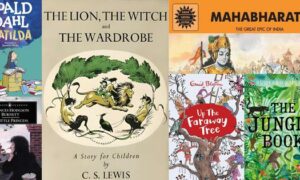Two sites in Lhasa are linked to the invention of the Tibetan writing system. Outside the east wall of the Jokhang, Songtsen used to meditate next to an auspicious boulder. Later he ordered the construction of a chapel next to it, the Jambhala Lhakhang (Chapel of Jambhala). The chapel has been fully absorbed into the grounds of the surrounding Meru Nyingma Monastery.
Songtsen dispatched Minister Thonmi to India, where he studied the then-existing 36 writing systems in order to devise one suited for Tibetan. His tutor, a Brahmin, was so impressed with the minister’s diligent research that he gave him the sobriquet Thonmi Sambhota (Thonmi, the Good Tibetan). Upon his return to Songtsen’s court, he devised an alpha-syllabary, a writing system that arranges symbols for sound in configurations of syllables.
The Tibetan script is primarily based on the Devanagari Sanskrit script, with adaptations for Tibetan and its grammar. The king joined his minister in this task by the Jambhala Lhakhang so frequently that his absence from court invited ridicule by lesser lights in the palace for his lack of attention to other duties.
Today the entrance of the Jambhala Lhakhang attests to its antiquity. It is a meter lower than the ground level of the surrounding courtyard. The chapel is designed in a style popular in India during the Gupta dynasty. You descend a few steps to an east-facing sanctum with an ambulatory enclosed by solid mud plaster walls painted red with yellow etchings of guardian protectors. In the niche to the two doorways to the chapel are images of the deities Jambhala and Namtösé (Vaisravana in Sanskrit). An avatar of Avalokitesvara, Jambhala is the Buddhist deity who bestows good fortune and wealth to those who practice charity and compassion. The other door guardian, Namtösé, is one of the Four Heavenly Kings and the protector of the north entrance to Mount Meru. The boulder revered by Songtsen has been walled up for centuries in a room on the north side of the chapel.
After Thonmi perfected the Tibetan writing system, he unveiled it at Pabonka; this was once a secluded spot in the countryside with marvellous views of Lhasa, but today it struggles against suburbs that have climbed up to it, bringing traffic jams, diesel fumes, and hastily constructed buildings.
Songtsen meditated in the two connected caves in the side of the mountain; these are open to pilgrims and visitors alike. The caves are celebrated as “power places,” where a pilgrim might sense the spiritual energy accumulated there over centuries. It is worthwhile to sit peacefully and silently in the cave for a bit. (The monks will be thrilled if you do.) Above the caves is a massive rock formation that resembles a turtle, a symbol of stability. Songsten built a nine-story fortress on the site; it was turned into a monastery in the eighth century. Today what you see is a post-Cultural Revolution reconstruction.
Thonmi translated the Karandhavyuha Sutra, the text that King Lhaththori had received from the sky, and deciphered the significance of the om mani padme hum mantra. He unveiled his alpha-syllabary by carving the Six-Syllable Mantra into the mountain rock face at Pabonka. A subsequently built chapel to the Three Protectors now encloses the carving, which is behind an easily overlooked glass enclosure on the east wall. There are also seventh-century carvings of the Three Protectors on the rock face as well as bas-reliefs of the wrathful Chana Dorje (with two snakes coiled on his forehead), images of Avalokitesvara with an Amitabha Buddha on his crown, and the Maitreya Bodhisattva, all of which are thickly covered with new paint, signs of earnest but misguided reverence. Or so say art historians. Of course, the Six-Syllable Mantra carving by Thonmi is the primary reason to make the effort to visit Pabonka, given its historic significance for the Tibetan people.
Tibetans often purchase thin rectangular pieces of slate on which stone workers have carved the Six-Syllable Mantra. These are placed at open-air sites near temples and monasteries. These “mani stones” are an inexpensive way to earn merit both for the worshipper and the carver. Nicely “authentic” souvenirs too.
The writing system is massively frustrating for non-Tibetans because it retains archaic spellings that have no relation to modern spoken Tibetan. When precisely transcribed from Tibetan, “Chenrezi” (the Tibetan name for Avalokitesvara) becomes sPyang ras gzigs. “Songtsen Gampo” is Srong btsan sgam po. The central province of Ü is dÜbs. These anomalies come about because although the pronunciations of many Tibetan words have continued to shift over the ages, the alpha-syllabary used to write the language was last revised in the ninth century. This has led to many Tibetan spellings that are the equivalent of English’s knight, thorough, and colonel, but only more obstinately illogical (to an outsider’s thinking).
The writing system is important in proving ancient Tibet looked primarily to India for its religious and literary inspiration, not China. The implicit rejection of cumbersome Chinese characters and their vertical format overcomes the oft-made assertion that Tibet has “always” been a part of China. The alpha-syllabary also distinguishes Tibetan civilisation from the more culturally supplicant posture of ancient Japan, Korea, and Vietnam (in addition to other adjacent cultures, now vanished, that fell within the orbit of Chinese culture). Even the form of preserving literature emulated the Indian example of palm-leaf texts rather than the bound bamboo sticks of ancient China.
Excerpted with permission from Old Lhasa: A Biography, MA Aldrich, Speaking Tiger Books.
This article first appeared on Scroll.in
📰 Crime Today News is proudly sponsored by DRYFRUIT & CO – A Brand by eFabby Global LLC
Design & Developed by Yes Mom Hosting






